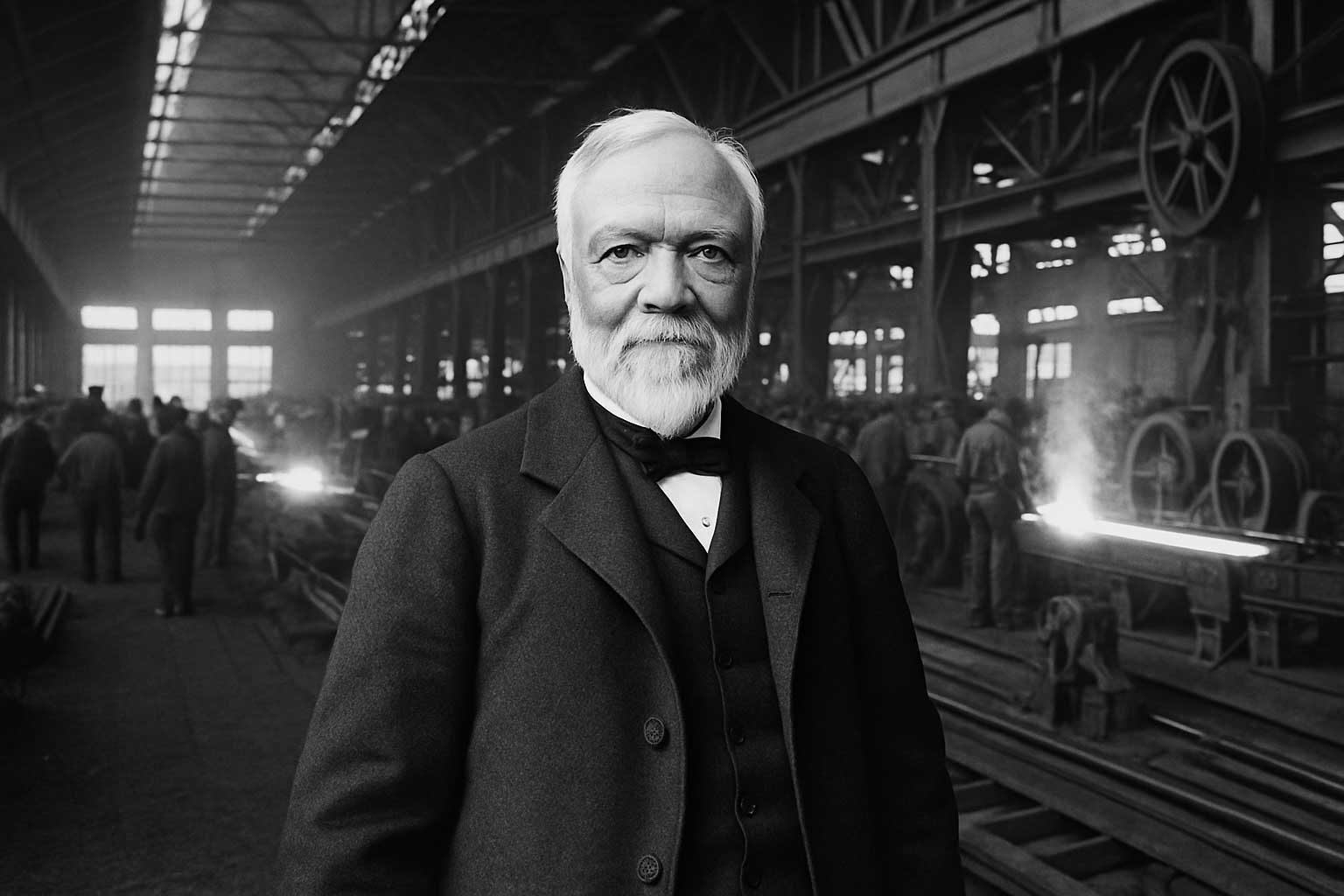Born: November 25, 1835 (Dunfermline, Scotland)
Died: August 11, 1919 (Lenox, Massachusetts)

He started poor. Dirt poor. Andrew Carnegie emigrated from Scotland at 12, worked as a bobbin boy in a Pittsburgh cotton mill, and fought his way up—letter by letter, ledger by ledger. No inheritance, no safety net—just strategy, hustle, and an appetite for control. Carnegie didn’t just get rich. He built the foundation of America’s industrial backbone and then wrote the rulebook on what to do with that wealth.
Andrew Carnegie Facts & Figures
| Category | Details |
| Peak Wealth | $350 million in 1901 (Roughly $309 billion today) |
| Sale of Carnegie Steel | $303 million to J.P. Morgan (largest deal of its time) |
| Libraries Funded | 2,509 worldwide |
| Major Legacy Projects | Carnegie Hall, Carnegie Mellon, Carnegie Foundation |
| Immigration Age | 12 years old |
| First Job | Bobbin boy earning $1.20/week |
| Business Strategy | Vertical integration, Bessemer process adoption |
| Philanthropy Given | ~$350 million (~90% of his fortune) |
Empire Builder: From Rails to Steel
By his 30s, Carnegie had made smart investments in iron, bridges, and railroads. But it was steel—scalable, essential, and under-optimized—that made him unstoppable. He backed the Bessemer process early, slashed inefficiency, and ran his mills like war rooms. His playbook? Own every piece—raw materials, transportation, production, distribution. That’s vertical integration before the term existed.
In 1901, Andrew Carnegie sold his steel empire to J.P. Morgan for $303 million, making him the richest man in America. U.S. Steel was born, and Carnegie walked away with generational wealth—and a mission.
The Gospel of Wealth: Big Money, Bigger Purpose
Carnegie didn’t just retire. He rebranded himself into a global force for good. His essay The Gospel of Wealth declared that the rich had a duty: don’t die rich—die useful. And he walked it. He gave away over $350 million in his lifetime, funding:
- 2,509 public libraries
- Carnegie Hall
- Carnegie Institute of Technology (now Carnegie Mellon)
- The Carnegie Foundation
- Peace and education programs across the globe
For Carnegie, philanthropy wasn’t charity—it was legacy engineering.
Passions Beyond Business

Andrew Carnegie loved books, music, and peace—not the soft kind, but the institutional kind. He funded Carnegie Hall to elevate culture in New York City. He founded the Carnegie Endowment for International Peace to prevent war through diplomacy and education. He didn’t just write about the better angels of our nature, he bankrolled them with his immense wealth.
He was also obsessed with self-education. His passion for learning started in night school and never left. For modern founders, it’s the perfect blueprint: get smart, scale hard, give back bigger.
Legacy: Business and Bloodline
Andrew Carnegie had one child—Margaret Carnegie Miller—but the empire didn’t stay in the family. He didn’t want a dynasty. He believed inherited wealth was a curse, famously writing, “The man who dies rich dies disgraced.” Unlike Rockefeller or Ford, Carnegie’s wealth was put to work for institutions, not heirs.
But his business legacy? Still alive. U.S. Steel, Carnegie Mellon, Carnegie Corporation, they bear his name and echo his values: efficiency, education, and scale.
Why Andrew Carnegie Belongs in the Inspired Founders Hall of Fame
Andrew Carnegie turned grit and steel into dominance and wealth. He scaled steel production with military precision and then flipped the narrative, becoming the blueprint for philanthropy at scale. He didn’t just build infrastructure; he built institutions that still shape society today. He proved that a founder’s true legacy isn’t the fortune they keep, it’s the one they give back. That’s what makes him Hall of Fame material.
Back to the Business Founders Hall of Fame
This isn’t just another rags-to-riches story. It’s rags-to-ruthless-to-reform. Andrew Carnegie belongs in the Inspired Founders Hall of Fame because he wasn’t just a capitalist building wealth, he was a capitalist with a conscience. When you see his name in that lineup next to Rockefeller, Ford, and Tata, know this: they all built empires. But Carnegie also built ideas that outlived him.






